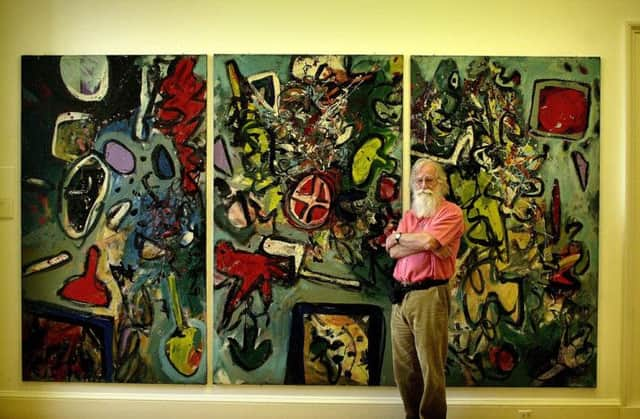Obituary: Alan Davie CBE, artist


With his mane of white hair and flowing beard, Alan Davie always made a strong impression. London’s Tate Gallery described his canvases for an upcoming exhibition at Tate Modern this month as “the result of an improvisatory process that the artist relates to his love of jazz”. Davie’s paintings were filled with symbolism and a glorious amalgam of colours; he never named a picture until he had completed it. He named The Birth of Venus “after seeing in it a distinct suggestion of the primeval womb; birth place, cavern, source of fruitfulness and love”.
His work brought him an international reputation and his admirers included David Hockney, Mark Rothko and Jackson Pollock. Davie championed American abstract expressionism after he had seen Pollock’s work in Peggy Guggenheim’s palazzo in Venice in 1948. It was his free style that inspired Davie to adopt a more improvisational approach.
Advertisement
Hide AdAdvertisement
Hide AdDavie refused to be stereotyped. He described himself as a painter, poet, jazz musician and jewellery designer. Significantly, an exhibition at the Barbican Gallery in London in 1993 was subtitled The Quest for the Miraculous. Davie brought together myriad cultures, religions and a sense of William Blake creating a sensation of startling power and originality.
James Alan Davie was born in Grangemouth, the son of a school teacher and a keen amateur artist who encouraged him to draw. There was also a strong musical link in the family – he was related to composer Cedric Thorpe Davie and the conductor Muir Mathieson – so it was not surprising that Davie demonstrated early musical talent and was a keen lover of jazz. After seeing the jazz saxophonist Coleman Hawkins playing in an Edinburgh record shop he switched from playing piano to the saxophone.
From 1938 to 1940 Davie attended the Edinburgh College of Art, where he studied under the distinguished professor John Maxwell. Davie was an outstanding pupil and won the Andrew Grant Scholarship. At the college he developed his use of vivid and often contrasting colours.
Andrew Patrizio, Professor of Scottish Visual Culture at Edinburgh College of Art, told The Scotsman yesterday: “Alan Davie maintained close contact with ECA and the University of Edinburgh over his entire life and will be sadly missed by his many Scottish friends and supporters. At his height, he was rightly considered a giant of 20th-century painting on the world stage, working continuously for around 75 years. He was a delight to work with and to know.”
In 1941, Davie left Edinburgh College of Art and served in the Royal Artillery for the last three years of the war. After the war he earned his money mostly playing saxophone in jazz bands and teaching jewellery design. One of his brooches was worn by the actress Vivien Leigh in one of her films.
He remained particularly proud of having played sax with Johnny Dankworth and Ronnie Scott.
He visited Venice and got to know Peggy Guggenheim, whose enthusiasm proved a powerful influence on his painting. She bought his Music of the Autumn Landscape, which enhanced his growing reputation, especially in America, where he was amazed at the sheer scale and boldness of Pollock’s paintings.
Davie returned to Edinburgh in 1946 and, the following year, married the artist and potter Janet “Bili” Gaul. They moved to London in 1949 just months before the birth of their only child, Jane, and later lived in Hertfordshire and Cornwall.
Advertisement
Hide AdAdvertisement
Hide AdDavie held his first London exhibition in 1950 at Gimpel Fils. Six years later he had an exhibition in New York at which many leading American museums were buyers. Davie’s works are now held in more than 50 public collections.
Davie always maintained a direct feel for his work, of immediacy and daring. There was little preparation – no early sketch – and his fertile imagination seemed to erupt on the canvas. The result was thrilling and hugely stimulating. He once said: “It’s an urge, an intensity, a kind of sexual need. I don’t practice painting or drawing as an art, in the sense of artifice, of making an imitation of something. It’s something I do from an inner compulsion that has to come out.”
In the 1960s Davie had established a style and versatility of his own. He had taken Paul Klee’s dictum of modern art that the artist “neither serves nor rules – he transmits”. Davie emphasised the importance of intuition both in his choice of subject matter and the enigmatic symbols.
In 1971 he made his first visit to the island of St Lucia, where he began to spend part of the year. The Caribbean colours and clear skies were to further influence his paining – notably in Bird Gong.
There is a Davey mural on a wall of the Coop in the centre of Grangemouth. In 2009 a prestigious exhibition was held at the Dovecot Studios in Edinburgh (The Creative World of Alan Davie) and the Art Extraordinary Gallery in Pittenweem showed some of Davie’s paintings. The National Galleries of Scotland own several of his works, including a vibrant self-portrait, a beguiling Homage to an Earth Goddess, and the vital The Magician’s Mirror. Patrick Elliott, senior curator, has described Davie as “one of the top three or four living Scottish artists”.
In his youth Davie had been a keen golfer and latterly was an avid skydiver – “much less risky than golf”. His personality reflected his art: direct, honest and dynamic. When asked if he wanted to live to be 100 he instantly replied: “I hope so… I’ve got lots to do.”
Davie was appointed CBE in 1972 and elected a Royal Academician in 2012. His wife predeceased him.